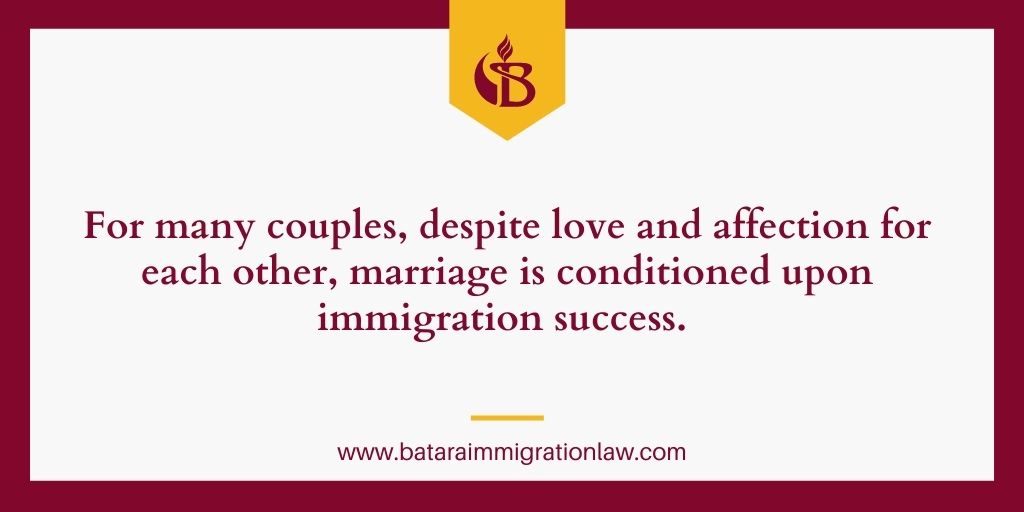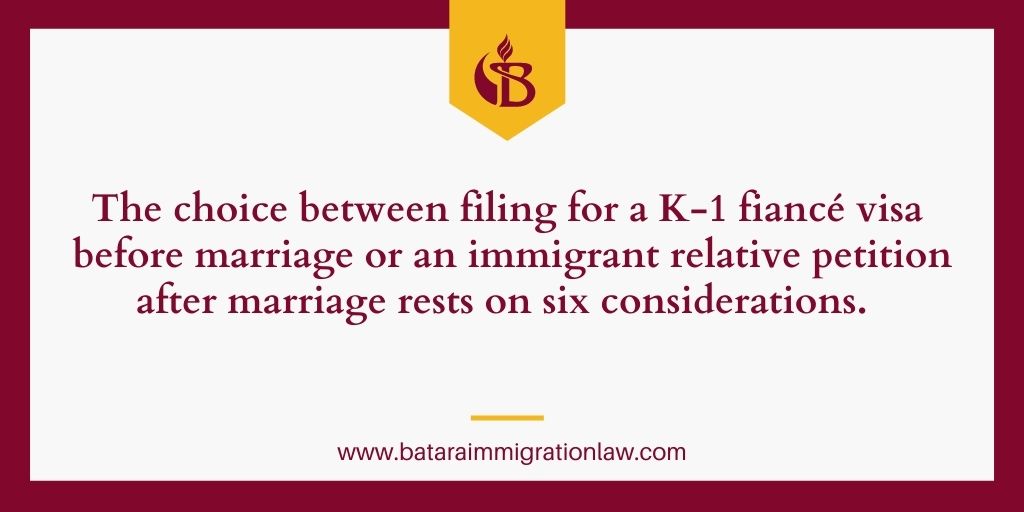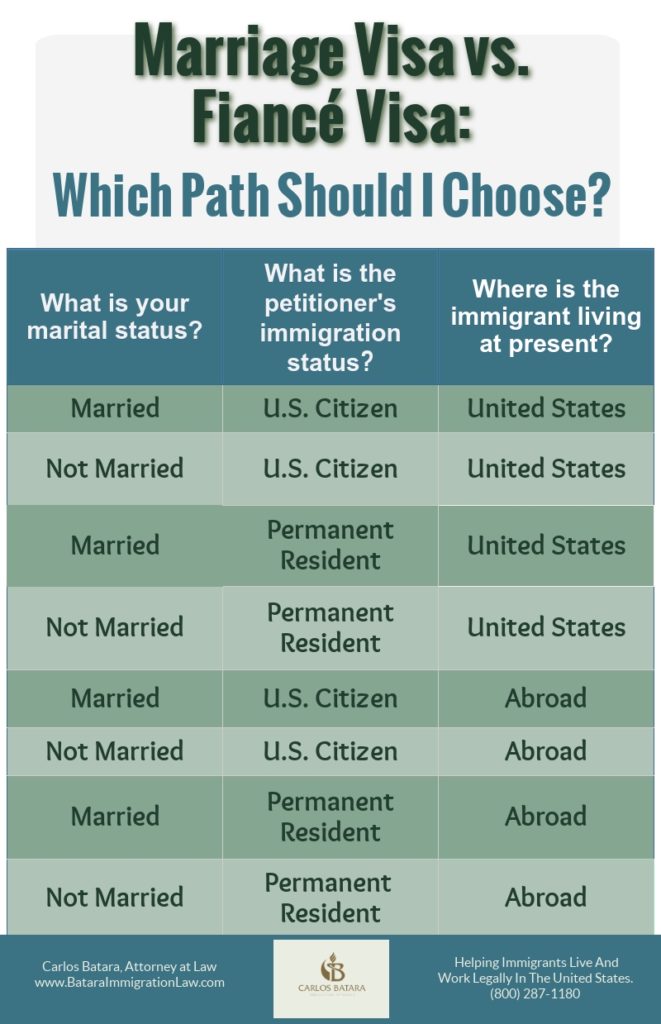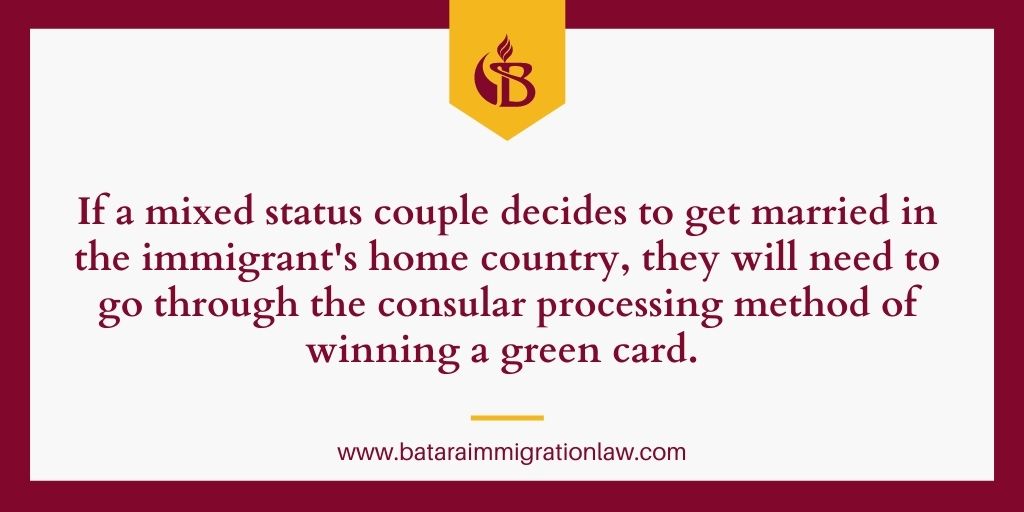
If you’ve been bitten by the love bug, you know what follows.
You start to think about this person all the time. Little things you do, from the food you eat to the clothes you wear, remind you of him or her. They’re on your mind throughout the day, day in and day out. They’re in your soul.
Sometimes the love bug bites when you’re visiting a distant land, hundreds of miles away from the United States.
Perhaps you went to see your grandparents. Maybe you were assigned there while you were in the military. Or it could be you and a few of your friends decided to take a short vacation.
You’ve decided to marry this person. But you’re not sure what immigration path to take, what immigration process to follow.

You’ve been told about filing a K-1 fiancé visa yet you’re not sure how it works. You’ve also been advised to simply get married and file a spousal petition.
You just want to know the answer to what seems an easy question, “What’s the best immigration path for us so that we can live together in the United States happily ever?”
Well, it’s not that simple. As I’ve learned, as a fiance visa lawyer for over 20 years, no two cases, no two situations are exactly alike.
In other words, the best path differs from couple to couple.
A Choice Of Petitions: The Fiancé Visa Application Before Marriage Or The I-130 Marriage Petition After Marriage?
For many couples, despite love and affection for each other, marriage is conditioned upon immigration success.
They make it clear at our initial strategy and planning session that if there is no legal path to legal residence for the immigrant fiancé, they will not get married. They refuse to live in the social shadows of American society and under a constant threat of deportation and separation.
Generally speaking, such couples have two legal options.
- The U.S. citizen can file an I-129F fiancé visa petition, after which the couple marries and files a permanent residence application for the immigrant newlywed.
- The couple can marry, then the U.S. citizen can file an I-130 immigrant relative petition for the spouse, followed by the paperwork to begin the green card process.
In this article, we’re going to focus on when filing for a fiancé visa before marriage may offer the best solution for you and the love of your life.
For more information on the specifics of filing an immigrant relative petition after marriage, see this page: Immigrant Relative Petitions And Visas.

Pathways To Green Card Success For The Immigrant Fiancé Of A U.S. Citizen
Recently, a young unmarried couple, Alejandro and Lee, visited my immigration office to explore their immigration options.
Lee was from China, and she was here on a student visa. Alejandro was a U.S. citizen. They had met in college in Houston. They were both graduate students.
They were thinking about getting married. They were wondering what was their best path: to get married first, then file immigration papers or file immigration documents, then get married.
They had heard about applying for a K-1 visa but they were unclear if that process presented the wisest solution for them.
While talking to his parents, Alejandro learned that I was an immigration attorney in San Bernardino for fiancé K-1 visa applicants from his mother.
They decided to arrange a strategy and planning session to explore the differences between the two alternatives.
As a couple with mixed status, they were in the best of all possible immigration worlds.
Lee had entered the U.S. lawfully. She was in lawful status. Alejandro was born here. As a result, Lee qualified to file for permanent residency – a process known as adjustment of status – if they married within the next few months. But that was not their plan.
They did not want to marry immediately. Lee planned to return home after graduation. Like many other Chinese fiancé visa applicants we’ve assisted, she was part of a strong family unit in her homeland.
She wanted to work at home for a few years, introduce Alejandro to her family, then marry.
Few unmarried mixed status couples are as fortunate as Alejandro and Lee. They are not entitled to file for permanent residency directly in the U.S.
Instead, they are limited to three possibilities.
Given Lee’s decision to return home, she, too, would be restricted to those three options.
First, Alejandro could file for a K-1 fiancé visa. Once the visa was granted, Lee could enter the U.S. Within 90 days of her entry, they would be required to get married, after which she could file to adjust her status to permanent residency.
Second, Lee could go home and return to the U.S. on a tourist visa. While here, they would get married. She would return home. Alejandro would file an immigrant relative petition for his new wife and process the application for permanent residence status via consular processing.
Third, Alejandro and Lee could get married in China. Similar to the second option, once married, Alejandro could file an immigrant relative petition, and they would process the application for permanent residence via consular processing.
Six Factors Why A Fiancé Visa Is Different From A Marriage Green Card
Ultimately, for Alejandro and Lee, as for most unmarried mixed status couples, the choice between filing for a K-1 fiancé visa before marriage or an immigrant relative petition after marriage rests on six considerations.
Three legal requirements. Three personal preferences.

Three Legal Considerations To Know Before Filing Fiancé Visa Or Spouse Visa
When assessing the viability of filing for a fiancé visa, three different legal requirements must be examined. Each requirement pertains to a different personal factor.
- Sometimes the couple is already married, other times they’re planning to get married.
- Sometimes the sponsoring spouse is a U.S. citizen, other times a permanent resident.
- Sometimes the immigrant lives in the U.S., other times in their home country.
Each answer leads to a potentially different course of action which the couple can take.
What Is The Couple’s Marital Status?
A fiancé visa petition cannot be filed if the couple is already married. A fiancé visa means just that, someone you’re going to marry, not someone you’ve already married.
When couples are already married, they are restricted to pursuing an immigrant relative petition.
What Is The Petitioner’s Immigration Status?
Only a United States citizen can file for an immigrant fiancé. A lawful permanent resident cannot. Because Alejandro is a U.S. citizen, he is entitled to file a K-1 petition on behalf of Lee.
This does not mean a legal resident cannot sponsor an immigrant for a marriage green card. Instead, the green card holder can apply to become a U.S. citizen, then file for either a fiancé visa or an immigrant relative petition. Or the couple can marry and attempt to immigrate on the basis of an immigrant relative petition under the provisions for a spouse of a permanent resident via consular processing.
Where Does The Immigrant Live?
To proceed under the fiancé visa process, the immigrant must reside outside the United States. Since Lee was planning to return home, she would be entitled to seek a K-1 visa.
To recap, a fiancé visa is only available in situations where (1) the petitioner is a U.S. citizen, (2) the couple is not married, and (3) the immigrant lives in another country.
The following chart lays out how these issues can vary from couple-to-couple.

Three Personal Considerations Before Filing K-1 Visa Or Marriage Green Card Visa
Now that we have discussed the primary legal issues, I’m going to explore the personal concerns which often overlay the official fiancé visa requirements.
In other words, a couple might qualify for a K-1 visa, yet decide on seeking an immigrant relative visa due to their individual beliefs and values. The most common concerns that influence a couple’s decision are:
- How Soon Does The Couple Want To Live Together?
- Where Does The Couple Want To Get Married?
- How Urgent Is The Fiancé’s Ability To Work?
Let’s take a closer look at these considerations.
How Soon Does The Couple Want To Live Together?
Some couples want to get married and start their joint life right now. They don’t want to delay things.
In this situation, the couple will be inclined to forgo the fiance visa process – instead opting to get married first, then going forward under one of the paths for a marriage green card.
Getting married sooner, however, is not the same as living together sooner.
If a couple has to file their papers for green card status via consular processing, it will take longer for the couple to be reunited physically than under the K-1 visa mechanism.
Where Does The Couple Want To Get Married?
In some cultures and religions, it is very important that a person gets married in their home country. If a mixed status couple decides to take this route, they will need to go through the consular processing method of getting a green card. Because of the marriage abroad, obtaining a fiancé visa is no longer possible.

Going back to Alejandro and Lee, if they decided Lee’s ethnic heritage mandated getting married in China, they would not be able to pursue a K-1 visa. After marriage, they would live separate for several months while the marriage green card process ran its course.
On the other hand, if they wanted to minimize their time apart, after Lee returned home, they could hold off on marriage in her home country to preserve the option of applying for a fiancé visa and reuniting sooner in the United States.
How Urgent Is The Fiancé’s Ability To Work?
A third personal concern for some unmarried mixed status couples is the desire on the part of the immigrant fiancé to work legally upon arrival.
In this situation, a fiancé visa will be disfavored. Since a fiancé visa is only a temporary visa, there is no right to employment authorization.
Rather, the immigrant fiancé is allowed to enter the United States, and within 90 days get married. Once married, the immigrant newlywed can file to become a lawful permanent resident, at which time the right to work legally in the U.S. is also granted. This process could take several months.
This means if the immigrant fiancé wants to arrive and be able to work right away, the couple will choose to file for green card status through the consular processing route.
Hence, even though winning a K-1 visa is possible for them, such couples will choose the alternative immigrant relative petition road to permanent residency.
To summarize, three personal considerations sometimes affect a couple’s decision to seek a K-1 fiancé visa or file a 1-130 immigrant relative petition: (1) how soon the couple wants to live together, (2) where the couple plans to get married, and (3) how urgently does the immigrant fiancé want to legally work in the United States.
Fiancé Visa vs. Marriage Visa: Which Path Is Better For The Love Of Your Life?
Returning to the inquiry posed at the outset of this article, “What’s the best immigration path for us so that we can live together in the United States happily ever?”
The answer, as illustrated above, differs from couple to couple.
Only you and the love of your life can answer this question.
In some instances, the legal requirements may preclude pursuing a fiancé visa. Only the immigrant relative pathway is open.
In other cases, where the U.S. sponsor and his or her betrothed qualify to file an I-129F petition for K-1 status, the decision depends on the couple’s personal preferences.
Whatever choice you make, may eternal happiness be yours together.
Ready to take a serious and honest look at the strengths and weaknesses of your immigration case? Let’s get started with a personalized strategy and planning consultation . . .




